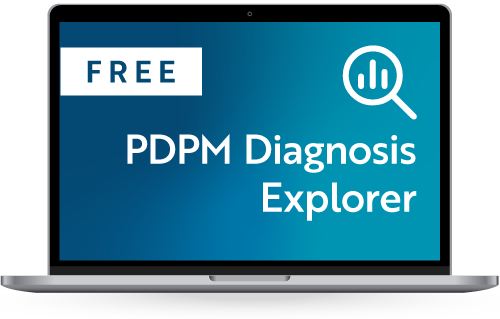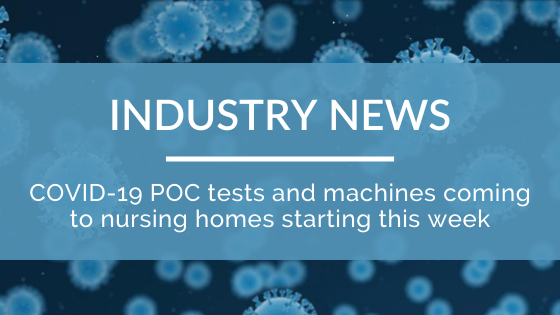If you listened to the Wednesday, July 22, 2020 CMS COVID-19 Nursing Home Call, you heard Evan Shulman, Director, Division of Nursing Homes for CMS moderating this afternoon’s 30-minute session. It was announcement that nursing homes with a CLIA (Clinical Laboratory Improvement Amendment) certificate would begin to receive 1 of 2 free testing machines (BD Veritor or Quidel Sofia) as well as tests starting this week. The initial distribution would be to a bit over 600 nursing homes and will continue over at least the next 14 weeks. Those nursing homes are categorized into 5 groups by size: small, small & medium, medium, large and major outliers (mega). These machines will allow nursing home staff to administer the rapid COVID-19 tests. There will be a one-time only shipment. Each nursing home can keep the machine – they own it once received. (Larger facilities will receive 2 machines.)
The catch to all of this is the requirement for a CLIA certificate waiver. Facilities that do not have a Clinical Laboratory Improvement Amendment (CLIA) Certificate of Waiver to administer the tests will not receive a testing instrument. The American Health Care Association reports that about 10% of the 15,400 facilities nationwide do not have the CLIA certification.
CLIA results from a 1988 federal law which governs standards for laboratory tests at health care facilities across the country. The CLIA requirements are based on the complexity of the test and the type of laboratory where the testing is performed. Overall, most state health departments allow nursing homes to perform routine tests on site, such as urinalysis and glucose checks, but officials must approve every new test available.
Health care facilities can apply for a CLIA waiver directly from the Centers for Medicare & Medicaid Services (CMS) or each state’s CLIA survey agency. This listing identifies the state contacts for CLIA waiver application. The How to Obtain a CLIA Certificate of Waiver guide provides information as well. This guide provides answers to many questions. Questions regarding CLIA can also be directed to CLIAcovidinquiries@cms.hhs.gov
One of the attendees on today’s call asked if the machines nursing homes will receive can also run influenza and RSV (Respiratory Syncytial Virus) tests. The answer was yes – excellent news for LTC facilities, residents and staff, especially during the flu season!
This call as well as information regarding the Rapid POC testing is to be posted by CMS “shortly.”
What did come a couple of hours after the NH Call was this Press Release: Trump Administration Announces New Resources to Protect Nursing Home Residents Against COVID-19.
“Today’s multi-pronged intervention represents the latest efforts in fulfilling that unwavering commitment. As caseloads continue to increase in areas around the country, it has never been more important that nursing homes have what they need to maintain a sturdy defense against the virus. These measures will help them do exactly that.” – Seema Verma, CMS Administrator
- The U.S. Department of Health and Human Services (HHS) will devote $5 billion of the Provider Relief Fund authorized by the Coronavirus Aid, Relief, and Economic Security (CARES) Act to Medicare-certified long term care facilities and state veterans’ homes (“nursing homes”), to build nursing home skills and enhance nursing homes’ response to COVID-19, including enhanced infection control. This funding could be used to address critical needs in nursing homes including hiring additional staff, implementing infection control “mentorship” programs with subject matter experts, increasing testing, and providing additional services, such as technology so residents can connect with their families if they are not able to visit. Nursing homes must participate in the Nursing Home COVID-19 Training (described below) to be qualified to receive this funding. This new funding is in addition to the $4.9 billion previously announced to offset revenue losses and assist nursing homes with additional costs related to responding to the COVID-19 public health emergency (PHE) and the shipments of personal protective equipment (PPE) provided to nursing homes by the Federal Emergency Management Agency (FEMA).
- Building on the initiative HHS announced last week, in which rapid point-of-care diagnostic testing devices will be distributed to nursing homes, and the new funding from the Provider Relief Fund, CMS will begin requiring, rather than recommending, that all nursing homes in states with a 5% positivity rate or greater test all nursing home staff each week. This new staff testing requirement will enhance efforts to keep the virus from entering and spreading through nursing homes by identifying asymptomatic carriers. Funds from the Provider Relief Fund can also be used to pay for additional testing of visitors.
- The Trump administration recently deployed federal Task Force Strike Teams to provide onsite technical assistance and education to nursing homes experiencing outbreaks in an effort to help reduce transmission and the risk of COVID-19 spread among residents. The first deployments took place in 18 nursing homes in Illinois, Florida, Louisiana, Ohio, Pennsylvania and Texas between July 18 and July 20. The Task Force Strike Teams are composed of clinicians and public health service officials from CMS, the Centers for Disease Control & Prevention (CDC), and the Office of the Assistant Secretary for Health (OASH[MM1] ). The Task Force Strike Teams went into nursing homes based on data they reported to the CDC that indicated an increase in COVID-19 cases. The teams focused on the four key areas of support, including keeping COVID-19 out of facilities, detecting COVID-19 cases quickly, preventing virus transmission, and managing staff. The goal was to determine what immediate actions nursing homes needed to take to help reduce the spread and risk of COVID-19 among residents, and to better understand what federal, state, and local resources nursing homes need to ensure the health and safety of their residents.
- CMS, in partnership with the CDC, is rolling out an online, self-paced, on-demand Nursing Home COVID-19 Training focused on infection control and best practices. The training being offered has 23 educational modules and a scenario-based learning modules that include materials on cohorting strategies and using telehealth in nursing homes to assist facilities as they continue to work to mitigate the virus spread in their facilities. This program supplements training already underway to better equip nursing homes to contain and stop the spread of COVID-19. The training is a requirement for nursing homes to receive the additional funding from the Provider Relief Fund Program.
- Early on during this pandemic, CMS required nursing homes to inform residents, their families and representatives of COVID-19 cases in their nursing homes. Starting in May, CMS and CDC began collecting weekly data on each nursing home including their number of COVID-19 cases. Now that this data collection process has matured, the White House and CMS will release a list of nursing homes with an increase in cases that will be sent to states each week as part of the weekly Governor’s report to ensure states have the information needed to target their support to the highest risk nursing homes.
This Press Release concludes with a list of public health actions for nursing homes on COVID-19 to date.
We’ll most definitely see at least one or more QSO notifications to correspond with the Press Release contents. I’ll blog on those when they’re available.
In related news during this call, Evan Shulman provided kudos to LTC facilities for NHSN reporting of COVID-19 data. He noted that “accuracy is increasing with very few facilities flagged for erroneous data and even fewer facilities not transmitting as required.” He asked that submitters ensure they are using their correct CCN and facility type. He also conveyed that the most common error is reporting cumulative data instead of new cases since the previous data submission. Shulman also reminded facilities to report resident deaths in their submission even if the resident expired at the hospital. The NHSN data submitted is posted to the data.cms.gov website. Facilities should check that website periodically (also the NHSN dashboard) to review the data submission. On the CMS website, watch for flags that will indicate whether or not your data passed NHSN or CMS quality assurance checks. He ended that portion of his remarks by saying that the “vast majority of data entered is accurate and actionable.”
Lastly, the latest Nursing Home Infection Control Surveys Data was posted later in the evening of July 22, 2020.
Want to keep up with the changing COVID-19 situation in skilled nursing?



